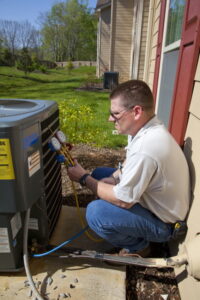
An air conditioning system uses refrigerant to cool the air. This refrigerant is a blend of chemicals that can easily change between liquid and gaseous states by evaporating and condensing. By evaporating refrigerant in the indoor coil and condensing it in the outdoor coil, an air conditioner moves heat from inside the house to the outside.
Over the history of electro-mechanical air conditioning systems, there have been many different refrigerants. Very early air conditioners used ammonia, sulfur dioxide, methyl chloride, or propane—all of which are either toxic, combustible, or both. This limited the use of air conditioning systems to commercial and industrial buildings. Eventually, ACs were designed to use safer refrigerants, and this is where we come to Freon and Puron. People often have questions about what these names mean and if it has an effect on their air conditioning system. We are here with the answers.
Puron and Freon are brand names for different refrigerant blends
What creates so much confusion about the term Freon is that people often use it to refer to any type of refrigerant in refrigeration equipment. But Freon is a brand name for a specific refrigerant blend also known by the name R-22 (which designates its molecular structure). R-22 is a hydrochlorofluorocarbon and was the main refrigerant for most air conditioning systems from the point where ACs entered residential homes.
But because R-22 creates ozone-depleting emissions, the US EPA began a program to gradually phase out its use. The phaseout accelerated with the development of a replacement refrigerant, R-410A, a chlorine-free blend that is less harmful to the environment as well as less toxic and more efficient. “Puron” is the brand name for R-410A.
As of 2020, the R-22 phaseout has been completed. The refrigerant is no longer manufactured, and old AC units with R-22 cannot have refrigerant replaced. We recommend an air conditioning replacement in Conyers, GA for any units that still use R-22. Construction of R-22 air conditioners halted in 2010, but most manufacturers had already switched to R-410A by this point. If you do have an R-22 air conditioner, it’s probably already at an age where it needs replacement.
But Puron is also heading for the exit door…
Refrigerant technology is always advancing and R-410A will eventually go the way of R-22 as more environmentally safe blends are developed. In fact, the phaseout process has already started. Carrier has developed Puron Advanced, R454B, as the best replacement for R-410A.
If you have an air conditioner installed after 2010, you don’t have to worry about the R-410A phaseout just yet. Commercial systems are the first units scheduled for replacement in the EPA’s staggered program, and the early stages of the residential phaseout won’t start until 2024. This gives you time to start considering your air conditioning plans. If your air conditioning system will be older than 10 years in 2024, you can start giving serious consideration to replacing it with the newest equipment using the next generation of refrigerants.
If you have any questions about your current AC and the refrigerant it uses, feel free to give us a call.
Call Premier Heating & Air and Experience the Premier Difference!

